Baba Harbhajan Singh Memorial Temple, Sikkim.
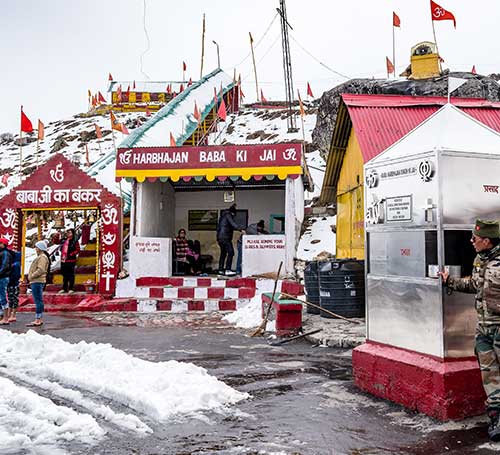
- : Between Nathula And Jelepla Pass, Gangtok, East Sikkim, Sikkim - 737131, India..
- : Closest airport: Pakyong (146 km), Closest railway station: New Jalpaiguri (167 km)..
- : 8am-2:30pm
- : 1 hour..
- : April-June is the ideal time..
- : Hotels and guesthouses available at Gangtok..
 Basic info
Basic info
Baba Harbhajan Singh Temple is an immensely popular spot in Sikkim, also known as Baba Mandir dedicated as the shrine of an ex-soldier named Harbhajan Singh. Located at an altitude of 13,123 ft and about 52kms from Gangtok, the temple falls in the route along the Tsomgo Lake and Nathula Pass. Today, the temple is visited by hundreds of people and devotees every day.
Baba Mandir is not considered as another temple, but there is a legend behind this unique temple which is believed to have wish-fulfilling powers. Legends date back to 35 years when Sepoy Harbhajan Singh of the 23rd Punjab Regiment went missing one day while leading a pack of mules from his battalion at Tukla to Deng Dhukla, both remote areas located in East Sikkim. A manhunt was started only to find his body after 3 days. Since then, many of the soldiers had dreams of Baba asking them to build a shrine commemorating him. The temple is, hence, in memorium of Baba Harbhajan Singh who is regarded as a saint by the locals.
 Tourist attractions
Tourist attractions
More than its religious significance, the temple is an interesting one that claims to have uncanny presence of Baba Harbhajan till the day. It is believed the saint visits the shrine every night, puts on his uniform and guards the entire area. People flock here in hundreds to get their wishes fulfilled. They leave bottles of water in rows in front of the shrine and take them back believing the water has magically curable traits.
 Things to do
Things to do
There is no such festival celebrated here in Baba Mandir. But every year on 11th September, a jeep carrying Baba's personal belongings departs to New Jalpaiguri and a berth is especially reserved for the Baba in the train. He is accompanied by three soldiers to his home who take a small sum of money to Baba's mother as contributed by the soldiers.
Changu Lake / Tsomgo Lake, Sikkim.
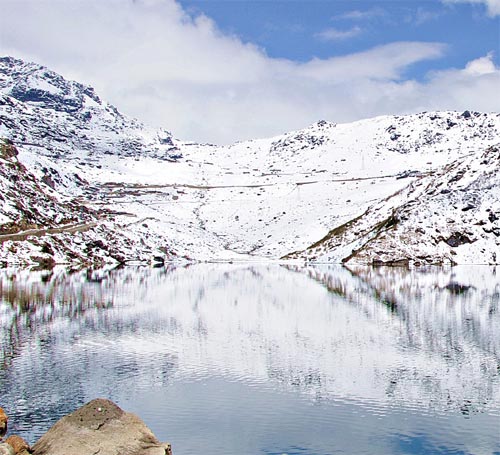
- : East Sikkim, Tsomgo Lake, Sikkim 737103, India..
- : Closest airport: Bagdogra (124 km), Closest railway station: New Jalpaiguri (159 km)..
- : 6am - 6pm.
- : 2 hours..
- : October-June is the best time..
- : Guest house, hotels and resorts available in Gangtok..
 Basic info
Basic info
Changu Lake of Tsomgo Lake is a pristine lake with wonderful surroundings and is one of the most visited tourist spots in Gangtok, Sikkim. The lake is located around 38 km from Gangtok linked through a snaky road amidst rocky mountainous topography with steep cliffs and rugged terrain. With an average depth of 50 ft, the lake is mostly frozen throughout the winter.
Considered among the top favorite and must visit places of Sikkim, the glacial lake is worshipped as a sacred one by the local people. The name is derived from the Bhutia language “Tso” meaning lake and “Mgo” that means head. At an altitude of 12,313 ft extended over a length of on 1 km with 0.5 km depth, the lake gets filled with water from the melting snow of the mountains surrounding the lake. The region enjoys a moderately high snowfall during the winter season and the lake is usually frozen during that period offering the visitors with several of options to try from.
 Tourist attractions
Tourist attractions
The Tsomgo Lake is situated at the Indo-China border and the scenic beauty has an uncanny similarity with that of Switzerland. The main attraction of the lake lies in the fact that the color of the water keeps on changing as the surface of the lake reflects different hues in different seasons. For the same reason, it is considered as a sacred lake and the water is believed to have medicinal qualities. There are several prayer wheels surrounding the lake with colorful prayer flags fluttering to demark the region. The route to the lake is itself an adventure and a visual treat.
 Things to do
Things to do
Yak ride is among the most popular to-do thing in the Tsomgo Lake. The yaks are mostly found at higher altitude ranging from 9000 ft and colorfully ornamented with their horns covered in woolen knits to make them more attractive. These yaks take the tourist for a round around the lake to cover the scenic beauty of the region. There are several small temples dedicated to Lord Shiva for the devotees to visit and worship. Needless to say, the entire area is a photographer’s paradise.
Directorate of Handicrafts and Handloom Emporium, Sikkim.
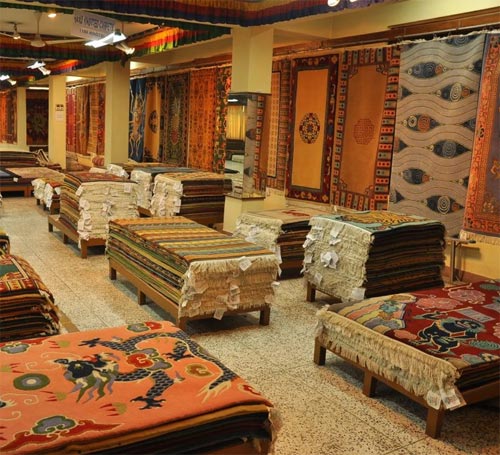
- : Zero Point, NH 31 A, Gangtok, Sikkim - 737101, India..
- : Closest airport: Pakyong (32.5 km)..
- : 10am-4pm (Sunday closed
- : 1 hour..
- : December is the ideal time..
- : Hotels and resorts available..
 Basic info
Basic info
The Directorate of Handicrafts and Handloom Emporium is an Indian government initiated institute located in Gangtok which was established in 1957 with the sole purpose to promote and preserve the fine ethnic arts and crafts of Sikkim. It stands out for being the training-cum-production center with 20 more similar units spread all over in Sikkim.
This center was started during the time of the Chogyals of Sikkim, as a promotional measure to encourage and propagate the craft and skills of local and village artisans. Today, the emporium is one of the major tourist attractions for thousands of people visiting Sikkim every year. The emporium is a repository of exclusive hand-woven blankets, carpets, shawls, apparels and all kind of furniture and other household decorative items.
 Tourist attractions
Tourist attractions
There are separate stalls for traditional handicrafts, furniture, carpets, and several other products for display and sell both. It is pure delight to go for shopping inside the institute amidst colorful handmade objects. Even if you don't buy anything, the concept, efficiency, work mode and procedures are certain to lure you as well as enlighten you with the local craftsmanship.
 Things to do
Things to do
It is a paradise for the ones who love to decor their house with classy and elegant handicrafts. Pick a thing or two as souvenir to commemorate your visit.
Do Drul Chorten Rumtek Monastery, Sikkim.
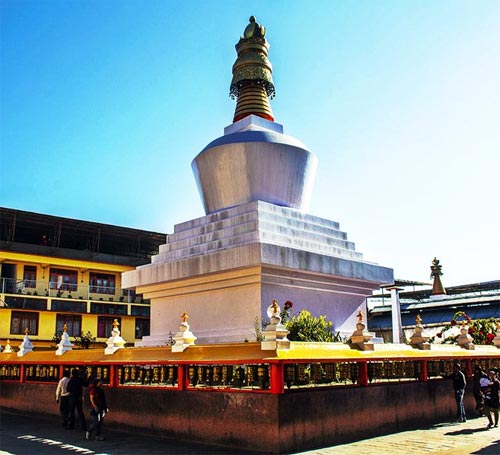
- : M.P.Golai, Tadong, Gangtok, Sikkim - 737102, India..
- : Closest airport: Pakyong (26.4 km), Closest railway station: Darjeeling (95.6 km)..
- : 8am - 6pm
- : 1 hour..
- : October-March is the ideal time..
- : Hotels and homestays available .
 Basic info
Basic info
Do Drul Chorten is a Buddhist stupa located around 3 km from Gangtok and adjacent to Namgyal Institute of Tibetology. Among the most magnificent and the biggest stupas in Gangtok, the stupa was constructed in 1945 under the leadership of Trulshik Rinpoche, head of the Nyingma order of Tibetan Buddhism in 1945 CE. There is a preaching center established by Dodhrubchen Rinpoche inside the premise of the Do Drul Chorten.
Legends say that the entire surrounding of this place was haunted by evil spirits killing many people who wandered around this place. It was after Trulshik Rinpoche visited the place for hermitage and built this stupa to repulse the spirits. There is a complete set of Dorjee Phurba, holy books (Kangyur) and special religious artifacts inside the stupa adorned with 108 prayer wheels known as Mani Lhakor in local language.
 Tourist attractions
Tourist attractions
Do Drul Chorten is a must visit place for nirvana seekers, history lovers and photography buffs. The serene ambiance and the tranquility of the monastery have always attracted tourists and devotees since ever. Phurba, as it is better known as, the white Chorten Stupa is marked by a golden top dome which is visible from several places of Gangtok. Dorjee Phurba or Vajra Kilaya is the deity enshrined on top of the stupa, and the Chorten Lakhang surrounds the two huge statues of Guru Rinpoche, also known as Guru Padmasambhava. Among the major tourist attractions is the girdled prayer wheels that count up to a total of 108 with Om Mani Padma Hum engraved on them.
 Things to do
Things to do
One must check out the Kanjur holy books, relics, complete mantras and several other religious objects that are preserved inside the stupa. There are several small stupas around the main one which makes the entire region attractive and a favorite among tourists. Another must visit place is the dharma preaching center established by the celebrated lama Dodhrubchen Rinpoche, and the building can accommodate over 700 monks.
Enchey Monastery, Sikkim.
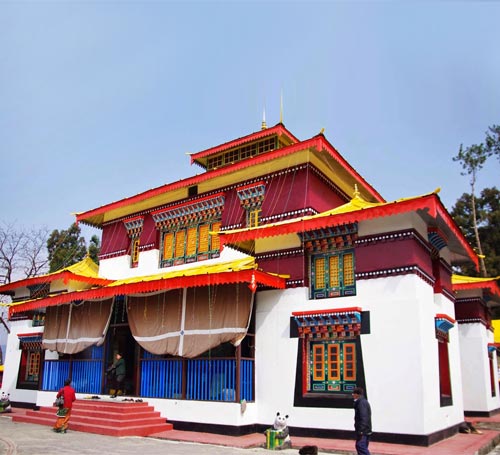
- : Gangtok-Nathula Road, Gangtok, Sikkim - 737117, India..
- : Closest airport: Pakyong (30.8 km); Closest railway station: Darjeeling (100.1 km)..
- : 6am-4pm
- : 1-2 hours..
- : September-October during the Detor Cham festival..
- : Homestays and hotels available..
 Basic info
Basic info
Enchey Monastery is a 200-years old monastery that belongs to the Nyingma order of Vajrayana Buddhism. Located around 3 km northeast of Gangtok, the location was blessed by Lama Drupthob Karpo who had flying powers inherited from tantric art in Buddhism. The name of the monastery is derived from its literal meaning the solitary temple which was built in a small hamlet of Gangtok that became a religious centre later.
The monastery was first built in the 1840s by the 8th Chogyal which made it a popular pilgrimage. However, the present structure of the monastery dates back to 1909-1910 during the reign of Sidkeong Tulku. There are around 90 monks who reside in the Enchey Monastery, belonging to the Nyingma sect. The main deities worshipped in the monastery are Buddha, Loketeswara and Guru Padmasambhava, although many images of several gods, goddesses and religious significance are ornamented in the interiors of the monastery.
 Tourist attractions
Tourist attractions
The Enchey Monastery is a tourist's favorite pious monastery that pays respect to Loki Sharia, Lord Buddha, and Guru Padmasambhava. The main attraction of the place is a massive metal roofed prayer hall with numerous colorful images depicting religious significance in some way or the other. The walls of the large prayer hall are entirely covered with paintings that include four religious kings, the deities of the four cardinal directions and the complete galaxy of Mahayan Buddhist deities. The shining golden cupola at the top of the monastery adds further to its beauty at the exterior.
 Things to do
Things to do
Anyone can go and offer their prayers in the monastery which follows Nyingma Order of Buddhism. The unique architecture is an artistic adaptation of Gyanak Riwo Tse-Nga (the sacred mountain with five peaks) in China is a beautiful visual treat. The most attractive thing to do is to watch the Chaam dance which is a special prayer offered by the monks wearing masks. The festival is celebrated on the 18thand 19th day of the lunar month as per the Tibetan calendar. Last, but not the least, the captivating location amidst the beautiful surrounding is a thing to behold and relax your soul with.
Ganesh Tok, Sikkim.
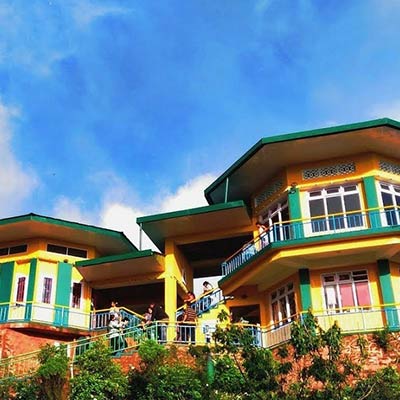
- : East District, Gangtok 737101, India.
- : Ganesh Tok is situated at a distance of 6 km from Gangtok Town and is easily accessible using a local transport..
- : 6:00 AM - 7:00 PM
- : 1-2 hrs.
- : March and June..
- : Budget & Luxury Hotels available..
 Basic info
Basic info
Ganesh Tok is a small temple and famous viewpoint in Gangtok, Sikkim. Perched on a hill, the attraction offers awe-inspiring views of the Kanchenjunga hill. The temple on the hill is so small that only one can visit it at a time. There is also a lounge and a balcony in front of the temple. These are also the major highlights of the place. Moreover, Ganesh Tok is surrounded by mountains and hills. In all, the attraction is a well-suited place for photographers and nature lovers.
Gurudongmar Lake, Sikkim.
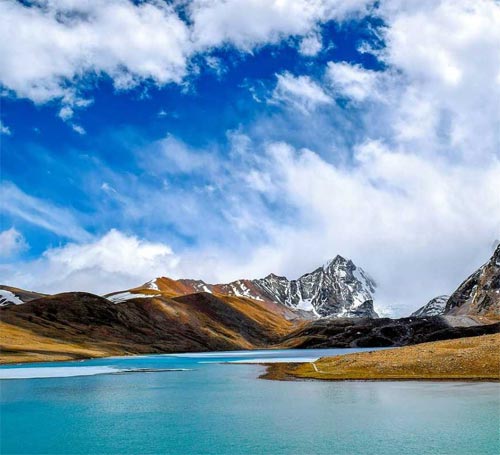
- : Gurudongmar Lake, North Sikkim, Sikkim - 737120, India..
- : Closest airport: Pakyong (204 km); Closest railway station: Darjeeling (171 km)..
- : 9:00 am - 5:00 pm
- : 2-3 hours..
- : February to April is the best time to travel..
- : Hotels and resorts available..
 Basic info
Basic info
Located at an altitude of 17,800 ft, the Gurudongmar Lake is one of the highest lakes in the world which lies in North Sikkim. The lake is named after Guru Padmasambhava (also known as Guru Rinpoche) who was the founder of Tibetan Buddhism. For the same reason, the lake is considered to be sacred. Another legend says that the spiritual leader of Sikhism, Guru Nanak blessed the lake in the 15th century while passing through the area.
The beauty of the lake and its surrounding is certain to sweep off your feet. The lake remains frozen in the winter during the months November to March. There are barren mountains in the surrounding and the snow capped Kanchenjunga range is also visible from here. The pure water of the lake seems surreal with beautiful hues of blue that creates ripples along the surface of the lake. Spread across the an area of 290 acres and the peripheral length stretching to 5.34 km, the lake is fed by glaciers and sits spectacularly in a high plateau area connected with the Tibetan Plateau.
 Tourist attractions
Tourist attractions
The major attraction of the lake is its mesmerizing beauty which is topped with the serene atmosphere and several hues of blue. The water of the lake is so fresh and clear that the bed of the lake can be seen from the center of the lake. One can also climb up to a higher altitude to find yaks, blue sheep and other wildlife. Watching the snow capped Kanchenjunga range is also a major tourist attraction for the travelers visiting there in thousands every year.
 Things to do
Things to do
The Gurudongmar Lake is a paradise for the nature lovers as well as for the photography buffs. At the same time, it is a place for the adventurous ones to explore. People should visit the region to find some solace amidst the tranquil ambiance. The route from Thangu to Gurudongmar that passes through the rugged terrain with high alpine pastures covered with many rhododendron trees is by itself an out of the world experience.
Kanchenjunga Falls, Sikkim.
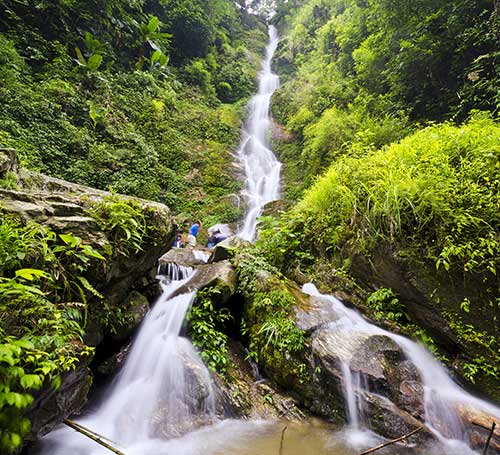
- : Kanchenjunga Falls, Sikkim - 737113, India..
- : Closest airport: Pakyong (131 km); Closest railway station: Darjeeling (90.9 km)..
- : 8am-5pm.
- : 2-3 hours..
- : September to December is the best time to visit.
- : Hotels, guesthouses and homestays available..
 Basic info
Basic info
Kanchenjunga Waterfalls is a beautiful tourist destination and is among the largest waterfalls of Sikkim. Located at a short distance of 28 km from the hill station of Pelling, the perennial waterfall is believed to have originated high up in the glaciers of Mount Kanchenjunga. Unlike majority of the waterfalls across the world, Kanchenjunga Falls is quite conveniently located next to the road and provides easy access as it pours off a cliff and settles into a pool below.
The strange fact about the waterfalls is that it had remained hidden behind thick forest and wasn’t known to people till the 90s, only to be discovered by a local tour operator who accidentally found it. Today, surrounded with lush greenery, it’s a divinely environment with the Kanchenjunga Falls making low roaring sound of water and the cold moist air adding to the charm. A small pathway leads to the waterfall connecting it with the main road. The sight of fresh stream water falling from the rocky cliff over the clear pool below is a sight to behold.
 Tourist attractions
Tourist attractions
The major attraction of the spot is the picturesque view of the surrounding enhanced by the backdrop of the mountains. It is a heavenly feeling to experience the lush green amidst the rumbling of the water stream. The rope slide connecting both the sides of the waterfalls is an adventurous experience to be enjoyed by those who want to pump up their adrenalin rush.
 Things to do
Things to do
One can enjoy the view either with bare eyes, or capture the beauty in their camera lenses. It is a photographer’s delight as well as an adventurous one’s paradise. The rope slide facility would take you from one end to another of the waterfalls crossing the high flowing water making splashes. One can also enjoy different types of food and local delicacies including hot beverages and snacks like steamed momos, tea, instant noodles, boiled eggs and many more.
Khangchendzonga Biosphere Reserve, Sikkim.
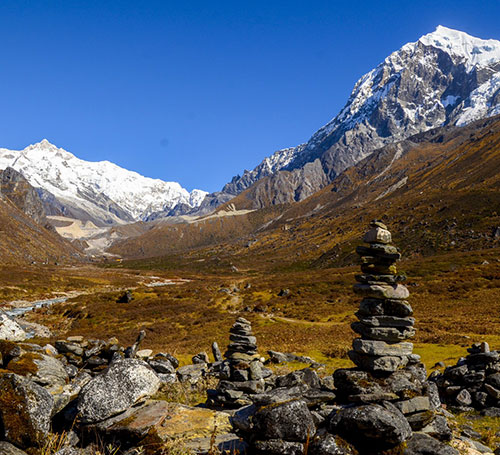
- : 31 A National Highway, Gangtok - 737101, Sikkim, India..
- : Closest airport: Pakyong (55.4 km); Closest railway station: New Jalpaiguri (221 km)..
- : 10:00am - 6:30pm
- : 1-2 hours..
- : March to May and September to Mid-December is best time to travel..
- : Hotels and resorts available ..
 Basic info
Basic info
Khangchendzonga National Park also Kanchenjunga Biosphere Reserve, located in Sikkim, is a National Park and a Biosphere reserve as declared in 1977 and inscribed as the UNESCO World Heritage Site as the first Mixed Heritage site of India. Covering a total area of 849.5 sq km, the biosphere reserve is located at an elevation of 6001 feet to 28,050 feet making it among the very few high altitude National Parks of India..
Located in Sikkim and bordered with Nepal to the west and Tibet (China) to the north-west, the biosphere reserve is one of the thirty-four biodiversity hotspots and includes vast natural forests supporting high species diversity with high levels of endemism. About 22 endemic and 22 rare and threatened plants are found in preserved in the area. While the flora is uniquely high, the fauna too is blessed heavily with several mammal species where the most prominent ones are musk deer, snow leopard, Himalayan tahr, wild dog, red panda, Tibetan wild ass, Himalayan blue sheep, Himalayan black bear, and reptiles like rat snake and Russell's viper.
 Tourist attractions
Tourist attractions
Well maintained and extremely well preserved, the national park is strictly protected for the betterment of the wildlife and biodiversity. The boundaries for developmental, forestry, poaching, hunting and grazing on cultivation are well marked and circumscribed and hence the tourists would enjoy the wildlife and biosphere at their best. The spectacular wilderness, the sky-touching snow-clad peaks towering above the undisturbed forest with lush green vegetation is among the major attractions for the visitors.
 Things to do
Things to do
While nature gazing can always be among the top things to do at Khangchendzonga National Park, the adventurous one would love to try trekking as lost of trek routes are available inside the park among which most routes starts from Yuksom. Come in touch with the Lepcha tribe to know more about their interesting culture, tradition and way of living.
Maenam Wildlife Sanctuary, Sikkim.
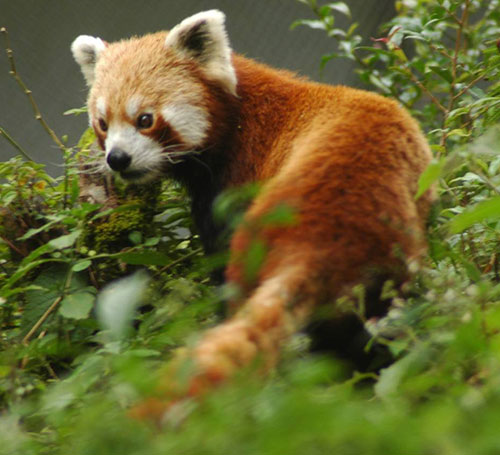
- : Maenam, Namchi, Sikkim, India..
- : Closest airport: Pakyong (30 km); Closest railway station: New Jalpaiguri (26 km).
- : 7am-5pm.
- : 2 hours..
- : March to June is the ideal time..
- : Guesthouses and hotels available in Namchi..
 Basic info
Basic info
Maenam Wildlife Sanctuary is a wildlife reserve in the South Sikkim district. Covering an area of 36.34 sq km of rich assortment of medical plants and herbs, the entire region is considered as a treasure house of medicines. The sanctuary is located on the Maenam-Tendong ridge bisecting Sikkim longitudinally from north to south. .
The sanctuary is located at an altitude of about 10,600 feet above sea level and a popular hotspot for travelers interested in trekking and nature exploring. The attitude ranges between 2300 m and 3263 m. The sanctuary houses several rare mammals, birds and reptiles making it a rich biosphere of fauna and avifauna. Interestingly, the flora is what names the sanctuary – where maenam-la means “treasure-house of medicines”. Established in 1987, the sanctuary is a perfect destination of photographers, adventure fanatics and nature lovers.
 Tourist attractions
Tourist attractions
The Maenam Wildlife Sanctuary mainly attracts the herbalists and the botanists – thanks to its vast vegetation of rare herbs with medicinal properties. The main attraction and the must visit place is right at the Maenam-Tendong Ridge where one can find rich flora of medicinal value. Rare animals like red panda, Leopard-Cat, Marbled-Cat, Civet-Cats, Serow, Goral, Barking Deer, and birds like Blood Pheasant, Magpies, Blue necked Pita, Common Hill Partridge, Sunbird and Black Eagle form a major part of wildlife sightseeing.
 Things to do
Things to do
Catch the wildlife at its best with some of the rarest of the species in animals and birds both. The stunning views of Mount Kanchenjunga and Teesta River are an absolute visual treat. One can also visit the nearby spots like the Maenam Gompa and a Temple dedicated to Lord Shiva among the favorite spots.
Namgyal Institute of Tibetology, Sikkim.
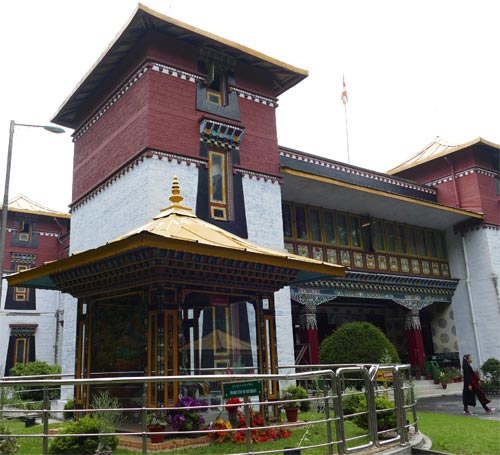
- : Deorali, Gangtok, Sikkim - 737101, India..
- : Closest airport: Pakyong (33.7 km); Closest railway station: Darjeeling (95.6 km)..
- : 10:00am-4:00pm (Sunday and Government holidays closed).
- : 1 hour..
- : Can be visited throughout the year..
- : Homestays, guest houses and hotels available..
 Basic info
Basic info
Namgyal Institute of Tibetology is a popular institute that promotes Tibetan culture, tradition, language, art, religion and more, and carries on researches in the same field. The construction defines the traditional Tibetan architecture located amidst lush greenery a sight that grab eyeballs of the tourists visiting there. The lush green grove where the institute stands tall, the serene aura attracts the visitors from all over the country.
The Namgyal Institute of Tibetology has a stock of a huge range of Buddhist manuscripts and books, and houses several beautiful items like stunning cloth painting with Tibetan art painted on them, sacred knick-knacks, and statuettes to name a few. The foundation stone of the institute was laid by the 14th Dalai Lama on 10th February 1957 on the land donated by by the late King of Sikkim Tashi Namgyal, because of which the institute bore its name. The institute was inaugurated by then Prime Minister of India, Late Pandit Jawaharlal Nehru on 1 October 1958.
 Tourist attractions
Tourist attractions
Embellished with golden lined towers, colorful frescos, mesmerizing murals and a wide array of windows on the top floor that overlooks beautiful sun-kissed peaks and scenic nature, Namgyal Institute of Tibetology is a must visit for people who are keen about the Tibetan culture traditionally celebrated at this part of the region. While the exterior portrays a mesmerizing Tibet-style mansion, the interior of the institute has a huge collection of artifacts that date back to the Vajrayana Buddhism and Tibetan culture. The major center of attraction is the majestic image brought from Tibet that depicts of Manjushri the Bodhisattva of knowledge.
 Things to do
Things to do
There is a library in the first floor with the largest collection of Tibetan literature in the whole world. The museum in the ground floor is a must visit to check out the unique collection of statues, coins, masks, thangkas, Tibetan art work & objects, and ancient manuscripts being stored as collected from the great monks and kings. One can also visit the souvenir shop Asta Mangala Art to pick items like German silverware, typical Sikkimese clothing, etc.
Nathula Pass, Sikkim.
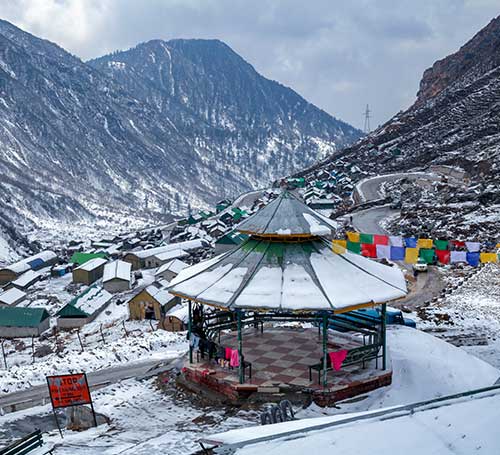
- : East Sikkim, Nathula, Sikkim - 737131, India..
- : Closest airport: Bagdogra (187 km); Closest railway station: New Jalpaiguri (171.7 km)..
- : 10am-4pm (Monday and Tuesday closed).
- : 1-2 hours..
- : May to October is the ideal time to visit..
- : Homestays, guesthouses, hotels and resorts available..
 Basic info
Basic info
Nathula Pass is one of the most favorite tourist destinations in Sikkim. Nestled in the Eastern Himalayas in Sikkim, it is a mountain pass that is nestled at an elevation of 14140 feet and the high altitude doubles up as one head towards the Indo-Chinese border that serves as the trade link between India and China. It is among the highest passes that are accessible via motorable road by tourists.
Nathula Pass is literally derived from Nathu meaning “listening ears” and La meaning “pass” in Tibetan language. The area isn’t permissible for foreigners, and the Indian citizens have to obtain a permit in Gangtok to visit the pass. Forming a part of the ancient Silk Road, Nathula is one of the three open trading border posts between China and India.
 Tourist attractions
Tourist attractions
The region is a tourist’s hotspot especially during the summer when travelers flock in the pass to experience the unusual phenomenon of the cold wind blowing across at great speed. The vegetation is rich giving rise to lush flora, and it graduates from sub-tropical forest at its base, to a temperate region, to a wet and dry alpine climate, and finally to cold tundra desert devoid of vegetation as it goes up in altitude. The change of vegetation from green to rugged terrain is a wonderful experience to sight.
 Things to do
Things to do
Though you will not sight many humans, the chance to catch a glimpse of yak, Tibetan graziers, sheep and pashmina-type goats is huge. Go for trekking, albeit with an experienced local guide. Photographers would have a luxurious time exploring the area which is a exceptionally beautiful.
Phodong Monastery, Sikkim.
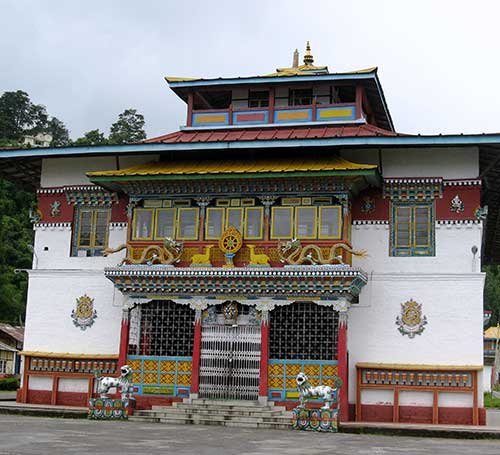
- : Singtam - Chungthang Road, Pelling, Sikkim - 737119, India..
- : Closest airport: Bagdogra (124 km); Closest railway station: Siliguri (114 km).
- : 8am-5pm.
- : 1 hour..
- : December-January during the festival, though can be visited throughout the year..
- : Guesthouses and hotels available..
 Basic info
Basic info
The Phodong or Phodang Monastery is a Buddhist monastery situated at Phodong, near Gangtok. Considered one of the six most important Buddhist monasteries, the Phodong Monastery is the most important pilgrimage in Gangtok that was built in 1740 AD by Gyurmed Namgyal, the fourth king of Sikkim. .
The Phodong Monastery follows rituals of the Karma Kagyu sect of Tibetan Buddhism. Perched at an altitude of 4500 feet, the monastery is among the oldest monasteries, which was affected by a severe earthquake. It was rebuilt in 1977 by the Lamas and the Sikkim Government had funded in the reconstruction to build one of the most beautiful monasteries of Sikkim.
 Tourist attractions
Tourist attractions
The monastery houses a total of 260 monks at the service of the religion and preaching. Beautiful murals, paintings and frescos adorn the walls of the monastery in the best way possible mesmerizing the visitors with their exquisiteness. Apart from the religious attractions, the scenic beauty is added by the picturesque view of the mountains and the valleys that surround the monastery.
 Things to do
Things to do
The Phodong Monastery celebrates an annual festival that is observed on the 28th and 29th day of the 10th month of the Tibetan calendar that falls during December-January. During this festival, the popular Chaam Dance is performed by the monks residing in the monastery. They also perform some religious rituals and prayers during the festival, as well as on regular basis and a part of their daily routine. It is an absolute bliss to watch more than 250 monks performing during the festival.
Rumtek Monastery, Sikkim.
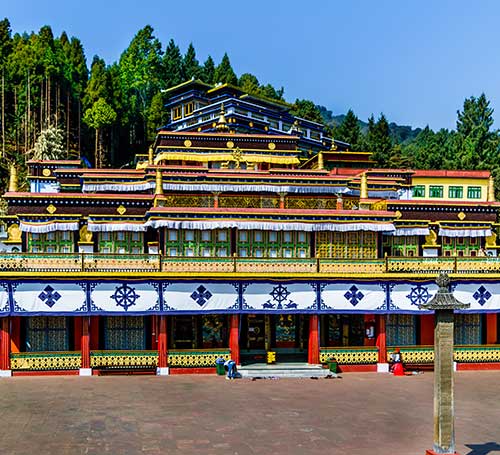
- : Tsurphu Labrang Pal Karmae Sangha Dhuche, Dharma Chakra Centre, Sikkim - 737135, India..
- : Closest airport: Pakyong (30.3 km); Closest railway station: New Jalpaiguri (120.7 km)..
- : 7am - 7pm.
- : 1-2 hours..
- : March to May and October to mid-December is the ideal time..
- : Lodges and budget hotels available..
 Basic info
Basic info
Rumtek Monastery, also called the Dharmachakra Center, is a gompa perched on top of a hill around 23 km from Gangtok in Sikkim. It is a beautiful Tibetan Buddhist monastery that was built in 16th century by the 9th Karmapa Wangchuk. The monastery exhibits the vision and objective of 16th Century Karmapa, Rangjung Rigpe Dorje.
Surrounded by the lush green and serene hills, the tranquil ambiance of the monastery works the best for the monks who come together around the courtyard of the Rumtek Monastery, which is considered as one of the most revered monasteries of India. The uniqueness of the monastery lies in the fact that pictures of Dalai Lama and Lord Ganesha at the entrance depicting linkage between Buddhism and Hinduism. There are Buddhist schools and nunnery where religion and culture are preached.
 Tourist attractions
Tourist attractions
The major attraction of Rumtek Monastery is the topmost part from where the travelers have breathtaking views of the entire Gangtok city that falls right opposite the hill where the monastery is perched. There are beautiful shrine temple and a monastery for the monks inside the Rumtek Monastery that enchant the travelers. The magnificent structure is totally surrounded by a walkway where the monks, pilgrims and tourists perform Kora or a religious circuit ritual. There is a golden stupa and several other sculptures belonging to the 16th Karmapa preserved inside the Rumtek Monastery which serves as a storehouse of thousands of religious items.
 Things to do
Things to do
Explore the Rumtek Monastery – the massive prayer hall inside is a stunning place to check out. Decorated with spectacularly colorful murals, statues, and ‘tangkhas’, the prayer hall is a must-visit. There are Relics Retreat Centre, ‘Shedra’ (monastic college), Nunnery, Stupas (protector’s shrine), Institutions for the amateur community and other establishments which are equally interesting, informative and enthralling for the ones visiting Rumtek Monastery with the beautiful backdrop of majestic hills and beautiful waterfalls.
Siddheshwar Dham, Sikkim.
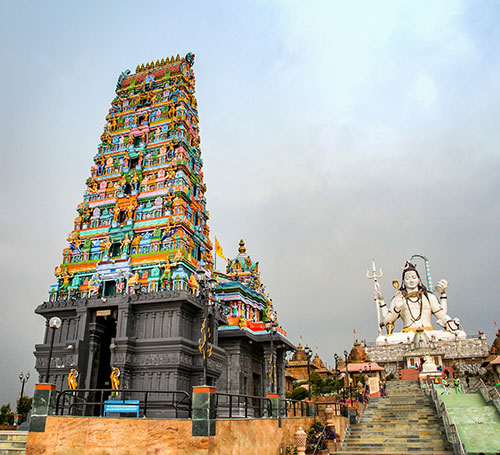
- : Siddeshwar Dham, Namchi, South Sikkim - 737126, India..
- : Closest airport: Pakyong (64.2 km); Closest railway station: Darjeeling (45.5 km).
- : 8am-7pm.
- : 1-2 hours..
- : Can be visited throughout the year, except monsoons, October during Namchi festival..
- : Homestay, guesthouses, hotels and resorts available..
 Basic info
Basic info
Siddheshwar Dham or Char Dham is a replica of all the four dhams – Badrinath, Dwarka, Jagannath Puri and Rameshwaram. Nestled on the top of Solophok hilltop, around 5 km from Namchi, Siddheswar Dham has a 108 feet tall statue of Shiva and a 18-feet statue of Kirateshwar a hunter incarnation of Shiva which makes it stand out as a pilgrim cum cultural heritage destination. It is built by Rural Development and Management Department, Government of Sikkim with state of art technology. The “pran-prathisthan” ceremony was completed on 8th Nov 2011 by Shri Jagadguru Shankarcharya Swami Swarupananda Saraswati Maharaj in the prescence of Hon’ble Chief Minister of the State Shri Pawan Chamlin.
The Siddheshwar Dham looks more like a theme park with the right hint of religion and culture and is spread across a total area of 7 acres. The main deity worshipped here in Lord Shiva that sits at the highest commanding point in the west direction and facing east. The entire complex is divided into four elements - Shiva Statue with 12 Jyotirlingas, Four Dhams, Sai Baba Temple and Kirateshwar statue along with Nandi bull, Sai dwar, Sai Temple, Kirat dwar, Kirateshwar Statue, Shiv Dwar.
 Tourist attractions
Tourist attractions
The main attraction of the Siddeshwar Dham is the huge Shiva statue that guards the entire complex. The pilgrimage has been dedicated and designed with the aim to preserve the true essence of Sikkim in everyone’s conscience, heart and minds. The state of Sikkim is a confluence of different people, culture, heritage, religion, language, and food, and the majority among these few classifieds are depicted in a way or other in the Siddheshwar Dham.
 Things to do
Things to do
The Siddheshwar Dham is abuzz with religious discourses, cultural activities seminars, and multiple celebrations throughout the year. However, Shivaratri and other festivals dedicated to the main deity Shiva get added attention and bigger celebrations attracting a huge number of devotees and pilgrims from all over the country and abroad.
Sikkim Himalayan Zoological Park, Sikkim.
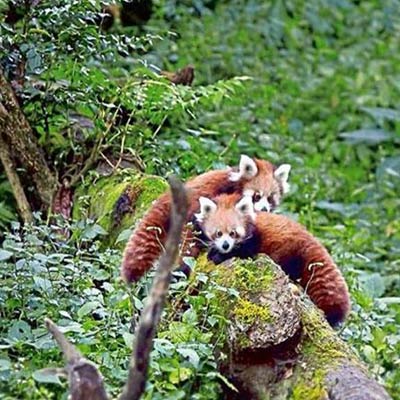
- : Bulbulay, East Sikkim, Gangtok, Sikkim 737103.
- : Do check for Public Transport options when you reach. Most tourists prefer to hire a car which is a lot more convenient in this hilly region..
- : The Zoo is open from 9am to 4pm daily (except Thursday)
- : 1-2 hrs.
- : February to May and Septembe.
- : Luxuries to budget hotels are available..
 Basic info
Basic info
Located 1780 m above sea level, Sikkim Himalayan Zoological Park is a real delight for wildlife lovers. Covering a huge area of 205 hectares in the mountainous terrain, the park is home to a wide variety of animals and birds, including crimson horned pheasant, Himalayan black bear, snow leopard, Himalayan palm civet, and many others. The zoological park also has facilities such as a souvenir shop, café, watchtower, etc. In short, the zoological park is a must-visit place if you wish to indulge in the natural beauty of North East India.
Yumthang Valley of Flowers, Sikkim.
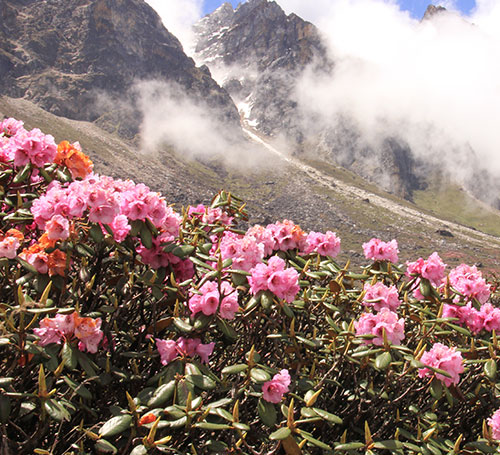
- : North Sikkim, Yumthang, Sikkim, 737120, India..
- : Closest airport: Pakyong (158 km), Closest railway station: Darjeeling (194.4 km)..
- : 8:00 am-5:00 pm.
- : 1-2 hours..
- : February-mid June is the ideal time to visit..
- : Guesthouses, hotels and resorts available at Lachung..
 Basic info
Basic info
The Yumthang Valley or Sikkim Valley of Flowers Sanctuary is a mesmerizing place in the North Sikkim district. Surrounded by the Himalayan mountains, the valley serves as a nature sanctuary bestowed with river, hot springs, yaks and grazing pasture on the lush green rolling meadows. Located at an elevation of 11,693 feet above sea level, the beautiful valley is around 150 km from the state capital Gangtok.
The Yumthang Valley is home to the Shingba Rhododendron Sanctuary exhibiting over 24 species of the state flower. The valley gets carpeted with countless flowers blooming in multicolor hues making the entire region a visual treat for the travelers. Primulas, rhododendrons, poppies, iris and other flora are what build up the valley and add to its picturesque beauty. However, the valley remains closed between December and March due to heavy snowfall. Also, a direct journey to Yumthang isn’t feasible and one must halt at Lachung to stay overnight and continue the next day.
 Tourist attractions
Tourist attractions
The Yumthang Valley is a paradise for anyone looking to experience a lifetime enchantment. It is the perfect destination for anyone seeking nature’s closeness amidst rivers, yaks, flowers, and hot springs. The major attraction for the tourists is the valley spread with colorful flowers and the Shingba Rhododendron Sanctuary with several varieties of rhododendron adding to the tranquility of the valley. A tributary of River Teesta flows right through the valley while a hot spring located on the right of the river adds as yet another major tourist attraction. The breathtaking views of mountains and waterfalls are spellbinding, while the lush green pine forest and silver fir trees act as the striking contrast to the vegetation-free Rocky Mountains present scenic view.
 Things to do
Things to do
Amidst rugged mountains, flowers, waterfalls and beauty, travelers are certain to get spoiled for choice. While trekking remains the main activity to reach the valley, treating your eyes with the flowers is something one mainly visits the valley for. You may also catch a glimpse of spotted Lingsang and Tiger. There is a Shiva Temple 6km north of the valley which is yet another favorite spot for travelers visiting Yumthang Valley.








